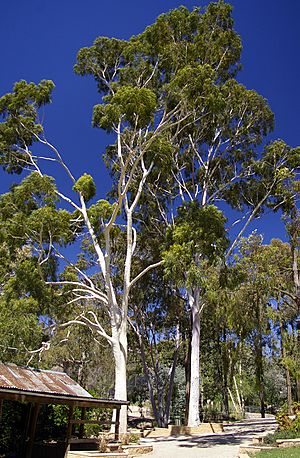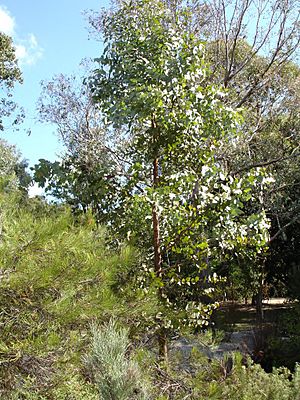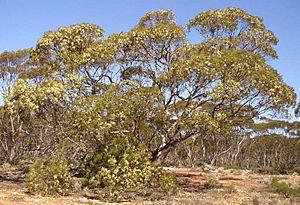Australian Inland Botanic Gardens facts for kids
Quick facts for kids Australian Inland Botanic Gardens |
|
|---|---|
| Type | Botanical garden |
| Location | Mourquong, New South Wales, Australia |
| Nearest city | Mildura |
| Area | 152 hectares (380 acres) |
| Established | 1989 |
| Vegetation | Australian Native and Non-Native |
| Connecting transport | Bus, Car |

The Australian Inland Botanic Gardens (AIBG) is a special place where plants grow, located in Mourquong, Australia. It is close to the city of Mildura and the Murray River.
This garden is the first of its kind in the Southern Hemisphere that focuses on plants that can live in dry, semi-arid areas. It is unique among other gardens in New South Wales and Victoria because it specializes in plants that are used to dry conditions.
Contents
History of the Gardens
The idea for the Australian Inland Botanic Gardens came from scientists at the Commonwealth Scientific and Industrial Research Organisation (CSIRO). The first meeting to plan the gardens happened in 1983.
How the Gardens Started
In 1988, the land for the gardens was given to the community. It used to be a place where sheep grazed. A group of volunteers, called the Friends of the Australian Inland Botanic Gardens, also started in 1988. The gardens officially began in 1989. John Wrigley, who was the first Director of the Australian National Botanic Gardens, created the main plan for the new gardens.
First Plantings and Buildings
The very first plants were put into the ground in 1991. Important people, Lady Stephen and Sir Ninian Stephen, who was a former Governor-General of Australia, helped by planting Eucalyptus citriodora trees along the entrance road. This first planting also included a display of Australian plants that can handle salty soil.
In the same year, a historic sheep station homestead called Garnpang was moved to the gardens. It was rebuilt and is now used as a visitor center, classroom, and a place for social events. The path around Garnpang is made from gypsum, a mineral found nearby.
Growing the Gardens
Full-time staff were hired in 1992. A pump was installed on the Murray River to bring water for irrigation. This allowed for more salt-tolerant plants and the creation of a beautiful Rose Garden. The first rows of roses were planted by Victoria's Governor, Richard McGarvie, and his wife.
In 1993, planting began in other sections, including areas for American and European plants. The Historical Society also gave ownership of Garnpang to the AIBG. Maps and plans about Garnpang were published in a book that year.
The irrigation system was finished in 1995. This allowed for planting in sections dedicated to dry land Australian, New Zealand, Asian, and African plants. A windmill was donated to the gardens, and a special train was bought from a nearby attraction to help visitors explore.
What You Can See at the Gardens
The Australian Inland Botanic Gardens is a large area, covering about 152 hectares (380 acres). It has many different sections for plants and nature.
Garden Sections
- River Frontage: This area along the river is planned for future use as a natural recreation spot and a place for boats. It covers about 42 hectares (100 acres).
- Clifftop: This area is set aside for future buildings and facilities.
- Mallee Sandhill: A fenced area of 109 hectares (270 acres) that protects native mallee plants.
- Nature Trail: A special path for walking and exploring the natural environment.
Plant Collections
The AIBG has over 20,000 plants, and about half of them have labels to tell you what they are. You can find not only Australian native plants but also plants from New Zealand, Africa, Europe, Asia, and the Americas.
The garden has old, mature mallee trees, some of which might be as old as 2500 years! These include Eucalyptus dumosa, Eucalyptus oleosa, Eucalyptus socialis, Eucalyptus gracilis, and Eucalyptus viridis.
The rose garden is very colorful with 1624 rose bushes arranged by color. There are also collections of local salt-tolerant plants and exotic plants from different parts of the world. You can also find a rockery with various plants growing among rocks.
How the Gardens Operate
The Australian Inland Botanic Gardens is run by a special committee. It depends on donations and help from volunteers. The gardens are cared for by paid staff and the Friends of AIBG volunteer group.
The gardens are part of important groups like the Council of Heads of Australian Botanic Gardens. They also work with Botanic Gardens Conservation International. The AIBG is a main partner for the Barkindji Biosphere Reserve, which helps protect nature.
Water and Care
Water for the gardens comes from the Murray River. A flag is used to check the underground water level, which is monitored by the NSW Department of Agriculture. A special fence keeps rabbits and kangaroos out of the gardens. Weeds are sometimes left to grow to help protect the soil from washing away. Mulch, which is a protective layer for plants, comes from local wineries and a saw mill. Blue markers on the ground help identify plant locations.
The gardens are open every day, and it is free to enter. There are no indoor exhibits, and plants are not sold. Plans are being made to build an interpretation centre to help visitors learn more about the plants and the biosphere.
Learning and Activities
The Bush Chapel, which was inspired by one of the CSIRO scientists, is used as a classroom for students who visit the gardens.
Students from Sunraysia Institute of TAFE come to the gardens to do practical work as part of their studies. La Trobe University also plans to use the gardens for research projects.
In 2008, a Green Corps environmental leadership training program started at AIBG. This program helps young people learn about protecting the environment.
On the first Sunday of each month, visitors can take a fun tractor/train tour around the gardens.
Bird watchers have identified at least 38 different types of birds living in the gardens.
See also
 In Spanish: Jardín Botánico de las Tierras Interiores de Australia para niños
In Spanish: Jardín Botánico de las Tierras Interiores de Australia para niños
- Gardening in Australia
- List of botanical gardens in Australia




